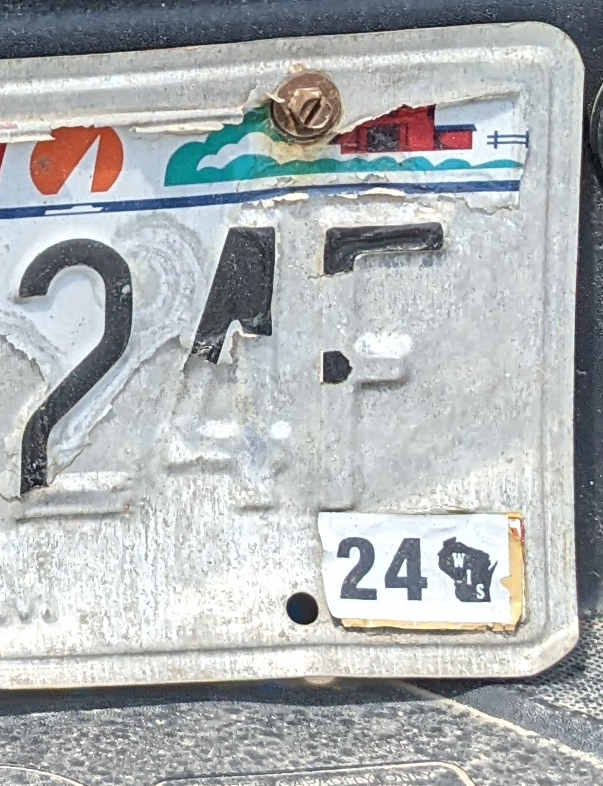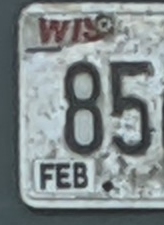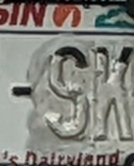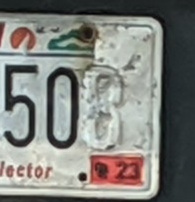

A few years ago I noticed an entirely new pattern: Wisconsin license plates where large sections of the coating and paint had peeled off. In decades of living here, that’s not something I had seen before, but “suddenly” it was common. So, what happened?
The first time I looked into this I discovered I’m hardly the first person to wonder. Multiple journalists looked into it. The answer?
Wisconsin DMV Administrator Kristina Boardman said if a license plate or its numbers are fading, chipping or deteriorating, it's usually due to prolonged exposure to weather and snow.
— Katrina Lim, " You Ask, We Answer: Why are some Wisconsin license plates illegible?"
“I contacted the DMV and they could not give me any reason other than age and weather...”
“There is no consistent pattern of plates delaminating within the first 5 years. The ones with issues you see on the road are generally 7 years old or older.”
— Robert Hornacek, "FOX 11 Investigates: Deteriorating license plates"
Really? Apparently “weather” and “time passing” are new things in Wisconsin.

HOW IS THIS ACCEPTABLE? These journalists failed. Asked to investigate a potential problem, they just asked the government and reprinted what was said. That is not an investigation. They failed the simple first step of “this seems to be new, did something change?”
Stenography journalism is part of what’s killing our country. I deeply appreciate that newsrooms are straining under budget cuts caused by the changing market (and some simple greed). Proper investigations are incredibly time consuming. But this? This is worse than useless, as it creates an illusion of an answer. It’s the sort of thing that will convince people “it’s always been this way” when... it hasn’t.
So for Mysterious Reasons, Wisconsin license plates didn’t regularly fail in this way. Around 2015, it became a problem. What changed? Let’s first let’s talk about human behavior and false economies.
There is a general rule that if you want people to behave in a particular way, you make it easy. If it’s hard, they won’t. This turns out to apply at every level.
Cities want people to recycle. Not because the cities love the planet or anything, but because it’s cheaper to recycle. The city probably still pays the recycling company to take the recycling, but because the company expects to be able to resell much of it, they charge the city less money than it costs to operate a dump. Recycling literally keeps your taxes down.

Ideally you have sorted recycling: different bins for paper, metal, glass, and plastic. This makes things much easier for the recycling company. They’ll need to deal with things in the wrong place, but much of the hard work is already done. However, cities that tried sorted recycling typically abandoned it. It was too much of a nuisance. You need to keep multiple different bins in your house to collect stuff and multiple bins outside for collection, and because you have multiple smaller bins you’re more likely to overflow at least one of them any given week. Facing the nuisance, people gave up and threw everything in the trash.
So now we have single-sort recycling. You still need to separate trash and recycling into different bins, but that’s it. Everything — paper, plastic, metal, and glass — goes in the same bin. It’s a little bit more work, but not much. It means the recycling company needs to do a lot of more work, so they demand more money from the city, but it’s still much better than not recycling.
Cities wisely chose to make things easier so people would actually do it.
Conversely, my own city used to collect large items and electronics from the curb. Then large items only got collected every other week and you needed to buy a special sticker to put on electronics that acted as a disposal fee. Now you need to special arrange pickup of large items and you need to bring electronics to the single drop off point in the city and you still buy the sticker... from a different location). I suspect a hell of a lot of large items and electronics are getting thrown in the garbage now. But in the short term, it looks like the city is saving money by not collecting large items and electronics!
So, what changed about license plates? A giant clue is in the WKOW article, but the writer didn’t understand the significance. It notes
She said lots of testing is done to ensure the plates last for at least five years...
and
DMV officials say there were 48,923 plate replacements in 2020 and 4.8 million plate renewals in 2020 in the state.
and as quoted earlier:
“There is no consistent pattern of plates delaminating within the first 5 years. The ones with issues you see on the road are generally 7 years old or older.”
Let’s say a license, on average, lasts 20 years before needing replacement, 4 times as long as what the state wants it to be. That means about 5% of plates should be replaced every year... but only 1% are. If plates really need replacement sooner than that, the ratio is even worse. That explains the peeling plates! Many plates are way past their expected lifespan. But this wasn't always the case. What changed?
Thankfully Jim Stingl actually investigated! He talked to more than just the Department of Transportation. He found confirmation that other people saw the pattern. And he identified the thing that changed!
(This is all from his article "Stingl: In another sign of the apocalypse, letters and numbers are peeling off our license plates". Sadly, it's paywalled.)
Here's the thing. There used to be an automatic replacement program for Wisconsin license plates on the road for about 10 years. New plates would be mailed out.
“With that program removed, the oldest auto plates on the road today are 19 years old,”...
THANK YOU JIM STINGL FOR DOING ACTUAL JOURNALISM. The column isn’t even supposed to be journalism; he’s a columnist.
He even went a step further and discovered that this has happened before in other states!
“You know, maybe the Wisconsin DMV should replace the plates for free. That's what New York and Illinois did after this same problem occurred there.”
I’M SO TIRED OF TURNING COSTS INTO EXTERNALITIES AND PRETENDING IT’S SAVING MONEY. It’s bad in large corporations, and the idea creeps into government from idiots who forget that government should serve its citizens, not the other way around.

We created an incentive to not replace old plates and sure enough, people stopped replacing old plates. In the short term it looked great on the budget; the costs of producing replacement license plates dropped 90%. And now we live with shitty plates that make our state look incompetant (fair enough) and hinders the single purpose of license plates: easy identification of vehicles.
Maybe eventually it’ll get bad enough that we’ll fix it like New York and Illinois, but I’m not optimistic. Blaming individuals for shitty systems is The American Way and, to the state, cheaper than doing the right thing.
It's $4 for a new set of regular auto plates, and you'll get a new license number. Old numbers are not reissued. Also, you will get nicked for a convenience fee if you use a credit card or a counter service fee if you show up in person.
Convenience fee. Counter service fee. I can just feel the encouragement to do the right thing flowing.